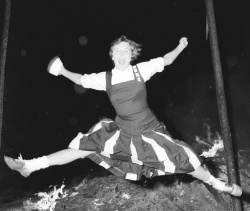
For the first time since its initial exhibition in 1978, Kate Millett’s chilling installation, The Trial of Sylvia Likens, has been reassembled. On Monday, the staff of the Sallie Bingham Center for Women’s History and Culture and Art History instructor Laurel Fredrickson joined with filmmakers Sophie Keir-Thompson and Mary Beth Ross to film the piece for a documentary about Millett’s life. The installation forms part of the Kate Millett Papers, which are held by the Bingham Center.
The installation marks Millett’s response to the horrific 1965 torture and murder of sixteen-year-old Sylvia Likens by the Baniszewski family and their neighborhood friends. Called “the most terrible crime ever committed in the state of Indiana,” the story of the murder and subsequent trial transformed Millett, laying the groundwork for her revolutionary work, Sexual Politics. Fredrickson writes, “For Kate, the case of Sylvia Likens exemplified in a very potent way how women are taught to accept punishment for real and imagined digressions from the cultural and social roles imposed upon them by patriarchal societies.”
In the photo essay below, Kelly Wooten, the Bingham Center’s Research Services and Collection Development Librarian, narrates Monday’s recreation.
The first step in reconstructing The Trial of Sylvia Likens was locating all the various mannequin parts, clothing, and panels, and then loading everything onto book trucks to convey to Room 217 in Perkins Library.
Once we delivered all the materials to Room 217 and the filmmakers set up their equipment, it was time to assemble the five defendants and get them dressed for court. Technical Services Archivist Megan Lewis and Art History instructor Laurel Fredrickson are putting on Johnnie’s jacket.
After all of the characters were ready, filmmakers Mary Beth Ross and Sophie Keir took shots of each mannequin in front of a green screen. This is Gertrude Baniszewski.
Filmmaker Mary Beth Ross prepares to capture images of the mannequins seated at the table.
For the original installation, Kate Millett created a death mask of her own face and dressed a mannequin in her own clothing to be arranged on a mattress as an embodiment of empathy for the victim, Sylvia Likens, who was found on a mattress in the family’s basement.
The trickiest part of this re-creation was hanging the panels that formed the backdrop in the original courtroom scene without damaging the library walls. Fortunately, Laurel Fredickson’s partner, Brad Johnson, is the Chief Preparator at the Nasher Museum of Art and had the time and the tools to hang the large newspaper reproductions.
For more photos, visit the RBMSCL’s Flickr photostream!
Thanks to the Bingham Center staff and Laurel Fredrickson for helping with this post!


















